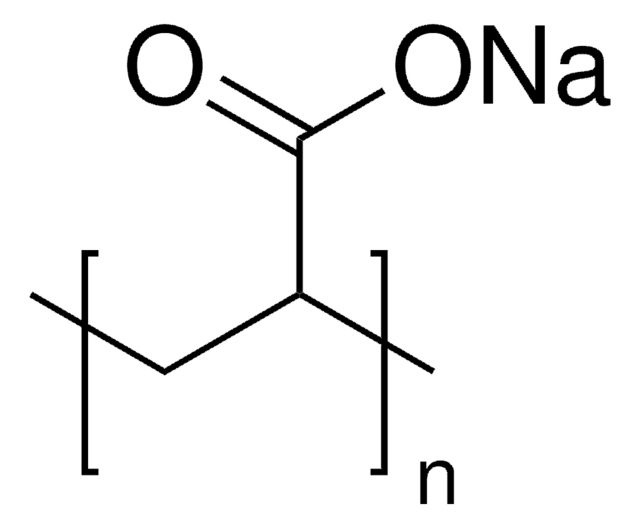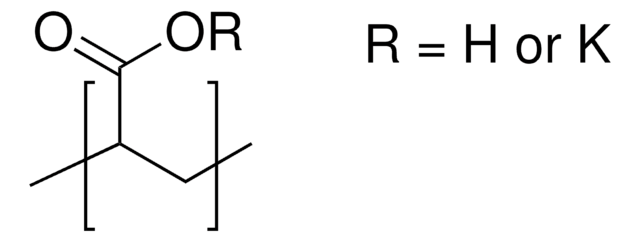306223
Ácido poliacrílico
average Mv ~3,000,000
About This Item
Produtos recomendados
reticulação
~0.1 % cross-linked
Nível de qualidade
peso molecular
average Mv ~3,000,000
viscosidade
30,000-40,000 cP
temperatura de transição
Tg 106 °C
InChI
1S/C3H4O2.Na/c1-2-3(4)5;/h2H,1H2,(H,4,5);/q;+1/p-1
chave InChI
NNMHYFLPFNGQFZ-UHFFFAOYSA-M
Procurando produtos similares? Visita Guia de comparação de produtos
Categorias relacionadas
Aplicação
- IR and Raman investigation of some poly(acrylic) acid gels in aqueous and neutralized state: This study explores the modification of local polymeric conformation of poly(acrylic) acid (PAA), induced by hydration and neutralization with triethanolamine, using IR and Raman spectroscopy. (M Todica et al., 2015).
- Phase Behavior of Aqueous Poly(acrylic acid-g-TEMPO): Research on poly(acrylic acid) grafted with TEMPO moieties, focusing on phase separation behavior over different pH ranges, which could be relevant for creating responsive materials. (Q Fu et al., 2016).
- Synthesis and characterization of poly(glyceric acid carbonate): a degradable analogue of poly(acrylic acid): This article presents a degradable analogue to poly(acrylic acid) and compares the properties of hydrogels prepared from this new polymer with those from PAA, relevant for biomedical applications. (H Zhang et al., 2015).
- Mechanically stable thermally crosslinked poly(acrylic acid)/reduced graphene oxide aerogels: Study on enhancing the mechanical integrity of reduced graphene oxide aerogels by intermixing with thermally cross-linkable PAA, pertinent to material science. (H Ha et al., 2015).
- Polyacrylic acid polymers hydrogels intended for topical drug delivery: preparation and characterization: Investigates the bioadhesiveness of polyacrylic acid polymers in hydrogels, emphasizing their potential in designing topical drug delivery systems. (G Calixto et al., 2015).
Palavra indicadora
Danger
Frases de perigo
Declarações de precaução
Classificações de perigo
Carc. 1A - Muta. 1B
Código de classe de armazenamento
6.1C - Combustible acute toxic Cat.3 / toxic compounds or compounds which causing chronic effects
Classe de risco de água (WGK)
WGK 3
Ponto de fulgor (°F)
Not applicable
Ponto de fulgor (°C)
Not applicable
Escolha uma das versões mais recentes:
Já possui este produto?
Encontre a documentação dos produtos que você adquiriu recentemente na biblioteca de documentos.
Os clientes também visualizaram
Artigos
Magnetic-plasmonic nanoparticles offer the combined benefits of both a magnetic probe as well as additional imaging modes usually associated with noble metal nanoparticles. Professor Shinya Maenosono (Japan Advanced Institute of Science and Technology) explores the synthesis, characterization, and proof-of-concept application of Ag/FeCo/Ag core/shell/shell magnetic-plasmonic nanobeads for imaging and isolation of cellular organelles (autophagosomes of COS-1 cells).
Nossa equipe de cientistas tem experiência em todas as áreas de pesquisa, incluindo Life Sciences, ciência de materiais, síntese química, cromatografia, química analítica e muitas outras.
Entre em contato com a assistência técnica



